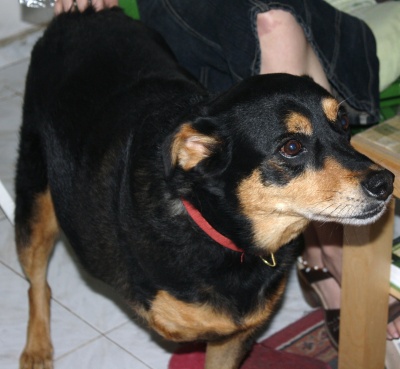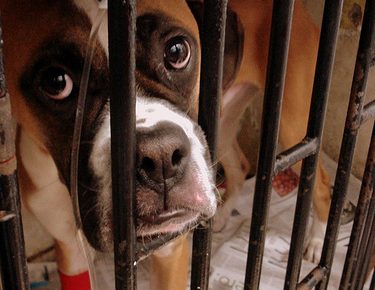What’s New in Cancer Treatments for Dogs: Page 1
It should be noted that the National Canine Cancer Foundation has awarded “Resvantage Canine” what they call their “Pink Paw Seal of Approval”, saying it is “a product that helps to advance the holistic health of our pets and helps fight canine cancer.” (Resvantage is Pfizer’s trade name for its resveratrol). The “Pink Paw” is awarded only to companies where the NCCF Scientific Advisory Board has determined that certain criteria have been met including rigorous quality standards.
Resveratrol is produced by plants as a defense against disease. It is a type of polyphenol which are antioxidants and has anti-inflamatory as well as anti-cancer properties. It is found in 70 plant varieties including grapes, red wine, pomegranates, raspberries, peanuts and Japanese knotwood. Since grapes are poisonous for dogs, choose a supplement where resveratrol is derived from other plant sources. Suggested doses of 5-7 mg. per 30 lbs. have had positive reports with no side effects.
Mirtazapine sold by Organon International Inc. under their trade name, Remeron, has shown to be a useful agent in the treatment of cancer in dogs, so says Dr. Demian Dressler. It has shown effectiveness in several ways – as an appetite stimulant, an aid against nausea and vomiting and has an antihistamine effect. And it acts as an antidepressant as well. Dr. Dressler suggests you consult your vet if your dog is on Prozac, Anipryl or Elanil since these drugs increase serotonin levels as does Mirtazapine and can cause a reaction.
February, 2010 – Daphne Reid at PetPeoplesPlace informs us that the United States Department of Agriculture (USDA) has approved ONCEPT Canine Melanoma Vaccine for use. The vaccine has shown to extend lives, sometimes indefinitely, in dogs with stage II or III oral cancer. This type of cancer is common and very aggressive and spreads throughout the body sometimes starting in the dog’s footpads and nails. The vaccine is now available to veterinarians. This vaccine is different from others in that it is not given as a preventive, but to slow down existing oral melanomas.
Curcumin
Many times, scientists look to Mother Nature for cures for disease. Curcumin, found in the spice Turmeric, has been found to inhibit COX-2, an enzyme that causes inflammation in the body. Curcumin given to humans in doses of 8 gms. daily has had no adverse effects.
Curcumin was shown to block a process called angiogenesis which is used by tumors to create new blood vessels to feed cancer. It has also been shown to slow tumor growth and metastasis.
Dr. Demian Dressler suggests giving 200 mgs. for a 50 lbs. dog, three times a day. There is a nutraceutical combination available called Apopcaps. As with all new medications, follow label directions and consult your vet/oncologist before using.
Dog slobber may hold the key to cancer research. Private donations from Pet Smart, Hill’s Pet Nutrition and federal stimulus grants are enabling Transnational Genomics Research Institute (TGen) and Van Andel Research Institute (VARI) to study saliva, blood and tumor samples from dogs that will enable understanding of rare human cancers. Mark Neff, director of VARI states that what can be done in human genetics can be done in dog genetics. With canine DNA samples it is hoped that the real genomic cause of cancer can be discovered. The study includes hemangiosarcoma (already in progress), osteosarcoma, oral melanoma, malignant histiocytosis and non-Hodgkins lymphoma.
Something to think about – Asparagus
These are highlights of an article printed in Cancer News Journal in December of 1979. It includes a number of case histories that the writer of the article and Richard R. Vensal, DDS, who has used asparagus to possibly treat cancer, have worked on. The asparagus must be cooked or canned can be used if it is free of pesticides and preservatives. The asparagus is then pureed and refrigerated. At least 4 full tablespoons should be given morning and evening. Water can be added and the asparagus drink can be hot or cold. Improvement may be in 2-4 weeks. Asparagus contains a high amount of a protein called histonis which is believed to control cell growth. Since asparagus is safe for dogs to eat in small amounts and if you like it, it certainly can’t hurt to try the pureed form. If it helps, so much the better. It should be noted that all vegetable have cancer-fighting properties. If your dog has difficulty urinating, check for crystals in the urine. Too much asparagus can cause this problem and lead to stones. Before making any changes in your dog’s diet, always check with your veterinarian.
Cancer weakens the immune system which is why we need to find ways to strengthen the immune system. Amino acids are the building blocks of protein. One of these is Glutamine. Dr. Demian Dressler writes that cancers cause a glutamine deficiency. Glutamine helps the body by blocking the effects of stress hormones on the immune system, lessens digestive upset and side effects that may occur with chemotherapy and radiation treatments and actually stimulates the immune system. However if your dog suffers from seizures and is on medication, glutamine may be contraindicated. Before adding any supplement, check with your veterinarian to be sure.
Stereotactic Radiosurgery (SRS) – SRS combined with chemotherapy ia a new curative treatment in the arsenal against cancer.
Osteosarcoma, a very aggressive cancer, is the most common bone cancer in dogs and humans. While it can afffect any bone, it usually occurs in the leg bones. OS can mestastize rapidly to other bones or the lungs. Standard treatment is amputation and chemotherapy with survival rate about 12 months. The advantage of SRS is that with its high dose of radiation, it can reach any anatomic location. Pre-treatment involves blood tests, chest x-rays, whole body nuclear bone scan and CT scan of the suspected area. The patient receives general anesthesia and undergoes 2-3 radiation treatments over 3-4 days along with chemotherapy. Improvement usually occurs within 1-2 weeks. Short term effects can be burns to the radiated area. Long term effects may be changes in skin or hair color, non-regrowth of hair, skin thickens or thins, bone weakness, all within the area of treatment.
Metronomic Protocol and Navy Protocol – The Metronomic Protocol is a timed, low dose chemotherapy that includes anti-inflammatories (NSAIDS), oral chemotherapy, anti-angiogenisis drugs that work by starving tumors of their blood supply, (angiogneisis – creation of blood) and bisphosphonates (prevent loss of bone mass). The anti-inflammatories used are Metacam, Piroxicam, Rimadyl and Deramaxx. Other drugs that make up the Protocol are Cytoxan, Previcox, Doxycycline and sometimes Lasix, a diuretic to prevent bladder infections commonly caused by Cytoxan. The Protocol can be given at any stage of the cancer. The Navy Protocol was named in honor of a dog named Navy who underwent the treatment successfully. The combination of drugs used in the Navy Protocol are Celebrex, tamoxifen and doxycycline.
Taurolidine– Oregon State University scientists in labora tory tests have sucessfully proved that Taurolidine, developed in Germany, can prevent osteosarcoma cells from increasing and can kill other cancer cells. Combined with doxorubicin, a widely used chemotherapy drug, it was more effective. Before moving on to clinical trials with patients, more lab studies will be conducted.
Dr. Demian Dressler warns us that Calcium Tablets can contain carcinogenic lead. Lead is thought to be a probable carcinogen. Since calcium is available in different forms, the safest supplement is Calcium Citrate instead of bone meal or oyster shells. Dogs with cancer should not be exposed to any carcinogens which can affect treatment and cause cancers to grow.
Highlights of an article written by Dr. Ananya Mandal, June 14, 2010
Queensland, Australia scientists have discovered a drug to
cure cancer that has effectively worked in
animals and is to be tried on humans in the next
phase of trials. This drug is plant-derived and
is called EBC-46 for trial purposes. The plant
from which it is obtained is found in the
Australian tropical rainforest. The drug has
shown to reduce inoperable tumors in 150 dogs,
cats and horses and a ferret to a significant
extent. The drug was developed over the past
six years from the seed of a rainforest plant
found in the Atherton Tablelands. Scientists
had cultivated their own plantation of the
plant since forming the company QBiotics Limited
in 2004.
QBiotics chief executive, Dr. Victoria Gordon, said in a statement, “Many pet
owners involved in veterinary trials of
EBC-46 have … literally watched the
deadly tumors on their pets disintegrate
within five to seven days of being treated…
It is absolutely amazing to see this drug
in action. The tumors almost shrink before
your eyes…We have had outstanding results
in the veterinary stage and it looks
promising for humans.” She explained that
the drug could be used as an injection
into a solid tumor or applied as a gel
over skin cancer. “It is a one-off
treatment to rapidly knock down the tumor…
Unlike other treatments like chemotherapy;
the drug … stimulates the body to destroy
the tumor, so we don’t see the negative
side effects.”
Dr. Gordon hoped that EBC-46 would be available
for veterinary markets in Australia and
New Zealand next year. Thereafter initial
trials on very small number of healthy adult
humans would commence.
QBiotics Ltd. plans to seek approval of the U.S.Food and Drug Administration before they can collaborate with a pharmaceutical company to sponsor $500 million for human trials.
Dr. Demian Dressler informs us of a new treatment for canine cancer. Produced by Royer Animal Health, the product is called Matrix III beads. The beads are the size of a small BB and contain a chemotherapy drug called Cisplatin. During surgery the beads are implanted into an area with cancer cells. As the beads break down, they slowly release Cisplatin. This means that a higher concentration of the drug reaches the cancer cells. Dr. Dressler further explains that this method requires smaller doses of chemotherapy, healthy cells receive very little of the drug and side effects are lessened. He goes on to say that some applications could be osteosarcoma, melanoma, fibrosarcoma, squamous cell carcinoma and others. It is a new therapy that shows much promise.
Studies in Canine Cancer being held at the University of Missouri:
A cancer drug used in humans is being studied at the Missouri College of Veterinary Medicine. Developed by CritiTech, the drug is known as Attaxol, developed specifically for dogs to be used by veterinarians. Chemotherapy drugs containing taxanes up to now have not been able to be used on dogs. Taxanes can keep cancer from proliferating throughout the body.
Inhalant cisplatin (a chemotherapy drug) for canine lung cancer which decreases sysemic toxicity and increases drug delivery to the lungs.
CycloSam – an OSA study involves an IV injection of this radioisotope to assess bone lesions in canine osteosarcoma patients.
Other trials at the University of Missouri involve canine prostate cancer, canine bladder cancer and canine lymphoma.
Check with the University of Missouri if you are interested and your dog meets the criteria and is a candidate for one of these studies.


